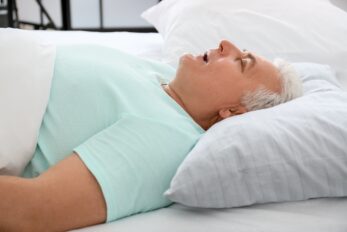If you follow our blog, you know that we talk about snoring A LOT. Do you snore? Have you ever wondered if your snoring could be more than just an annoyance to your partner? What if it signals something more serious, like sleep apnea? And what if sleep apnea and snoring are connected to type 2 diabetes? Grab your favourite cozy beverage and settle in as we examine the connection between sleep apnea and type 2 diabetes.
What is Sleep Apnea?
For the newbies, first things first, let’s talk about sleep apnea. Sleep apnea is a condition where your breathing repeatedly stops and starts during sleep. The most common type is obstructive sleep apnea (OSA), where the throat muscles intermittently relax and block the airway. It’s as if your body keeps hitting the snooze button on your breathing while you’re trying to sleep.
Symptoms of Sleep Apnea
- Loud snoring (the kind that could wake the neighbours)
- Episodes of stopped breathing during sleep (often noticed by a partner)
- Gasping for air during sleep
- Waking up with a dry mouth
- Waking up with a morning headache
- Insomnia or restless sleep
- Excessive daytime sleepiness
If any of these symptoms sound familiar, it might be time to talk to a member of our team.
What is Type 2 Diabetes?
Now, let’s switch gears and chat about type 2 diabetes. This is a chronic condition that affects the way your body processes blood sugar (glucose).
Symptoms of Type 2 Diabetes
- Increased thirst and frequent urination
- Increased hunger
- Fatigue
- Blurred vision
- Slow-healing sores
- Frequent infections
Again, if these symptoms ring a bell, it’s worth getting checked out by a healthcare professional.
The Sleep Apnea-Diabetes Connection
- Insulin Resistance: Research shows that sleep apnea can lead to insulin resistance, a precursor to type 2 diabetes. When your breathing stops and starts during the night, it stresses your body, leading to inflammation and increased blood sugar levels. It’s like your body is in a constant state of “fight or flight,” which isn’t great for your glucose control.
- Obesity: Both sleep apnea and type 2 diabetes are often linked to obesity. Excess weight can lead to the development of both conditions, creating a vicious cycle where each condition exacerbates the other. It’s like trying to outrun a snowball that keeps getting bigger.
- Poor Sleep Quality: Sleep apnea disrupts your sleep, leading to poor sleep quality and daytime fatigue. Poor sleep can mess with your hormones, increasing your appetite and cravings for unhealthy foods, which can contribute to weight gain and, consequently, type 2 diabetes.
Taking Control: Tips for Managing Sleep Apnea and Type 2 Diabetes
Now that we’ve scared you a little (sorry, not sorry), let’s talk about what you can do to take control of your health.
Managing Sleep Apnea
- CPAP Therapy: Continuous positive airway pressure (CPAP) therapy is the gold standard treatment for sleep apnea. It involves wearing a mask that provides a steady stream of air to keep your airways open. Sure, it might not be the most glamorous look, but waking up feeling refreshed is totally worth it.
- Weight Loss: Shedding excess pounds can significantly improve the symptoms of sleep apnea. Plus, it comes with a bunch of other health benefits, including better control of type 2 diabetes.
- Positional Therapy: For some, snoring and apnea episodes worsen when sleeping on their back. Consider switching to side sleeping (snuggle up with a body pillow for extra support) to help minimize these symptoms.
- Avoid Alcohol and Smoking: Alcohol and smoking can worsen sleep apnea, so cutting back or quitting can make a big difference.
Managing Type 2 Diabetes
- Healthy Eating: Focus on a balanced diet rich in fruits, vegetables, whole grains, lean proteins, and healthy fats. Avoiding sugary foods and refined carbs can help keep your blood sugar levels in check.
- Regular Exercise: Aim for at least 150 minutes of moderate-intensity aerobic activity per week. Exercise helps improve insulin sensitivity and can aid in weight loss.
- Medications: If lifestyle changes aren’t enough, your doctor may prescribe medications to help control your blood sugar levels. Always follow your doctor’s advice and take medications as directed.
- Regular Monitoring: Keep track of your blood sugar levels to see how well your management plan is working. This can help you and your healthcare team make any necessary adjustments.
The Sleep Therapeutics Advantage: Your Partner in Better Sleep and Health
At Sleep Therapeutics, we understand the complex relationship between sleep apnea and type 2 diabetes. Our team of experts is here to help you navigate this journey with personalized treatment plans, follow-up care, and top-of-the-line CPAP machines and equipment.
Contact Sleep Therapeutics for a free consultation and learn how we can help you achieve better sleep and better health.
If you’re experiencing symptoms of either condition, don’t wait to get help. Your body (and your bed partner) will thank you!






